Key takeaways:
- Feedback surveys are essential for understanding attendee experiences and areas for improvement in event management.
- Effective surveys balance open-ended and closed-ended questions, while clarity and timing significantly influence response quality.
- Analyzing feedback requires a systematic approach and collaboration with team members to uncover actionable insights.
- Incorporating feedback can lead to significant improvements in event structure and participant engagement, fostering a more connected attendee experience.
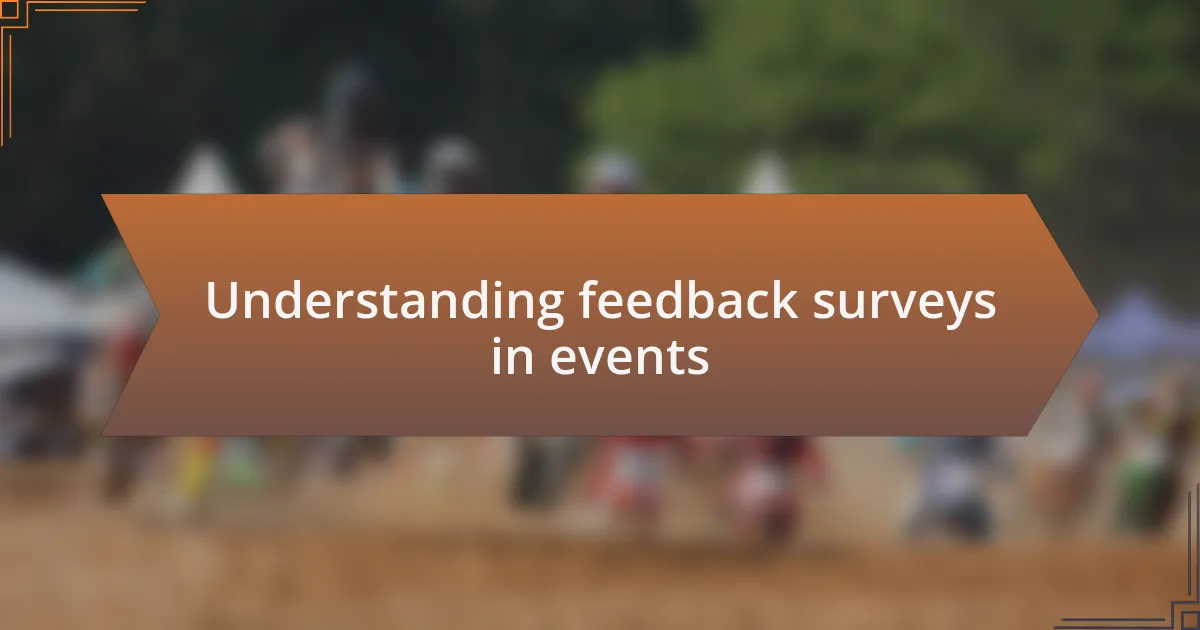
Understanding feedback surveys in events
Feedback surveys in event management serve as a vital tool for understanding audience perceptions and experiences. I remember hosting a conference where we implemented a simple survey at the end. The insights we gathered from participants not only highlighted what worked well but also unveiled areas that needed improvement, which was eye-opening for me.
Delving into feedback surveys can evoke a mix of anticipation and apprehension. As I analyzed the responses from one event, I felt a rush of excitement at the positive comments, but I also had to confront constructive criticism. Isn’t it fascinating how a few words on a form can bring to light aspects that might have gone unnoticed during the hustle of event planning?
Surveys offer a unique opportunity for dialogue with attendees that extends beyond the event itself. I often think about the emotional responses shared in these surveys; they remind me that every detail matters, from the choice of venue to the quality of speakers. Isn’t it powerful to realize that feedback can not only shape future events but also forge a stronger connection with participants?
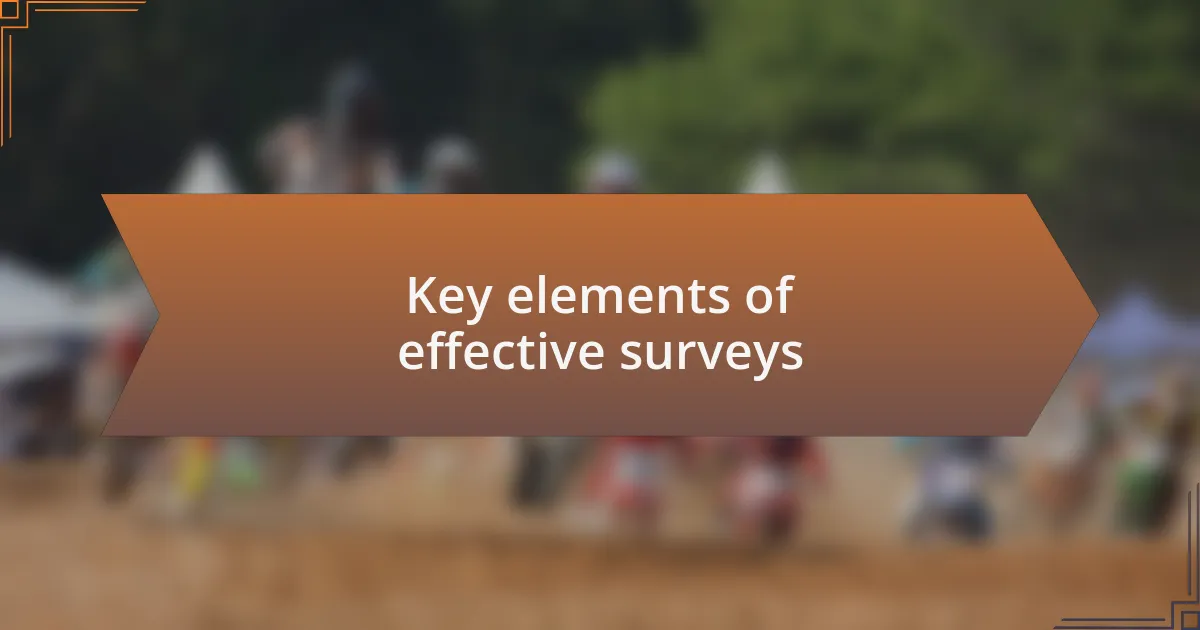
Key elements of effective surveys
When crafting effective surveys, clarity is paramount. I once designed a survey with overly complex language and confusing questions, only to realize later that many attendees struggled to understand it. Keeping the wording simple not only enhances the response rate but also ensures that the feedback gathered is genuinely reflective of attendees’ experiences. This experience taught me the importance of being straightforward and direct.
Another essential element is the balance between open-ended and closed-ended questions. In my experience, mixing both types encourages richer insights while also making the survey easier to analyze. I remember a specific event where an open-ended question allowed participants to express their creativity and concerns in unexpected ways, leading to ideas I hadn’t considered before. Isn’t it interesting how sometimes the best suggestions come from giving people a platform to share their thoughts freely?
Moreover, timing is critical in survey effectiveness. I’ve learned that sending a survey too soon can lead to rushed responses, while waiting too long may result in lost enthusiasm from attendees. For instance, after one major event, I waited just a couple of days to send out the survey, which prompted attendees to reflect on their experiences while the excitement was still fresh. This timing created an engaging dialogue that improved the overall quality of the feedback we received.
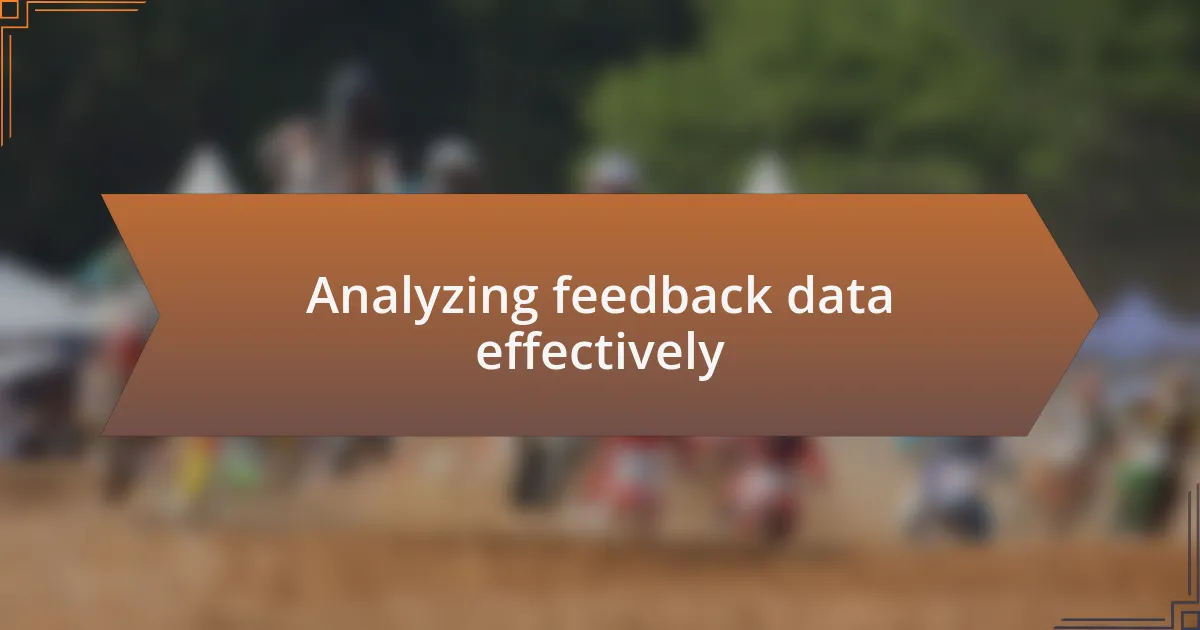
Analyzing feedback data effectively
Analyzing feedback data effectively requires a systematic approach. I remember diving into survey results after a particularly challenging conference. I categorized comments by theme to identify recurring issues. It was eye-opening to see patterns emerge from seemingly random feedback. Have you ever felt overwhelmed by data, only to find clarity in categorization?
Another important aspect is to prioritize actionable insights. After analyzing feedback from a recent social event, I was struck by how many attendees expressed dissatisfaction with the venue’s layout. By focusing on this key insight, I was able to make targeted changes for the next event, which ultimately led to greater attendee satisfaction. Sometimes, it’s easy to get lost in the numbers and forget about the human stories behind them.
Lastly, consider involving your team in the analysis process. I’ve collaborated with colleagues to discuss survey results, and it often brings fresh perspectives. Through sharing different viewpoints, we unearthed hidden gems in the feedback that I might have overlooked alone. Isn’t it fascinating how teamwork can amplify understanding and lead to decisions that better resonate with our audience?
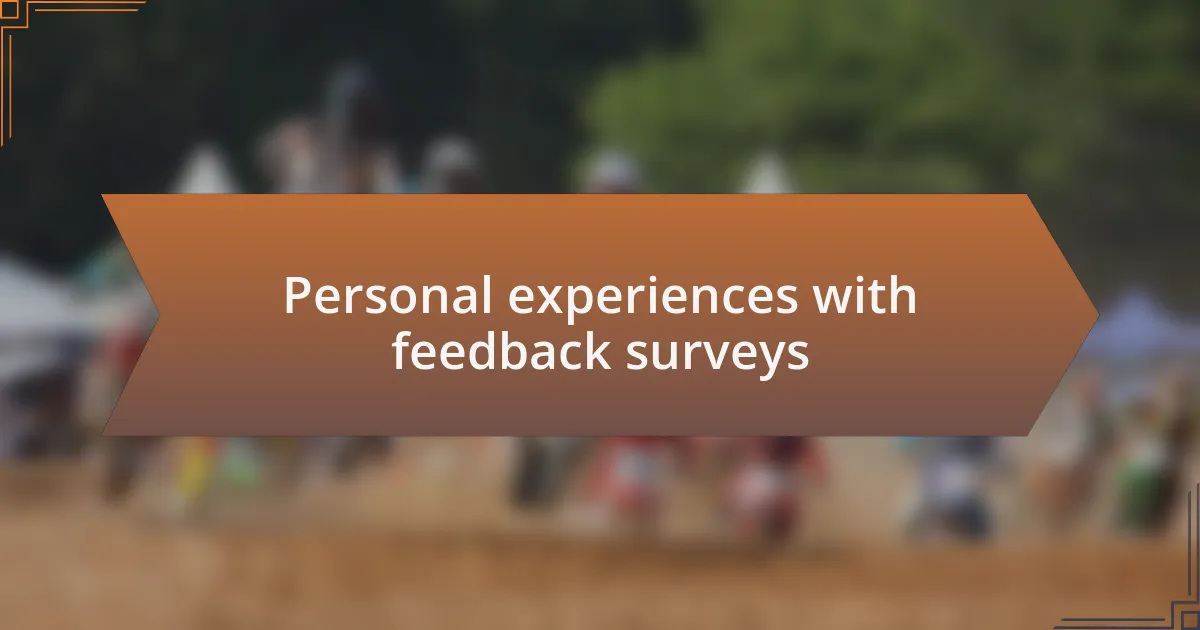
Personal experiences with feedback surveys
Feedback surveys have always been a mixed bag for me. Once, after a carefully planned networking event, I braced myself for the responses. I remember clicking through the results with anticipation, feeling a twist of anxiety in my stomach. The feedback was a blend of praise and constructive criticism, and it was illuminating to remember that even when things go well, there’s always room for growth. Have you ever opened a survey only to confront aspects you hadn’t considered? I certainly have, and it can be an eye-opener.
What truly struck me was how one piece of feedback altered my approach to future events. An attendee mentioned feeling disengaged during a particular session, which was hard to hear considering the effort we put into it. I took that comment to heart and realized that the format may not have been engaging enough. It was a pivotal moment for me, reflecting on how one individual’s experience could ripple out to affect many others. Isn’t it interesting how a single comment can catalyze change?
In another instance, I ran a follow-up survey after implementing changes based on previous feedback. I was thrilled to see increased satisfaction ratings! This journey through feedback underscored the importance of continuous improvement, and it felt rewarding to know that listening truly makes a difference. It’s incredible how much we learn from our audience when we keep an open mind. What lessons have you benefited from in your own feedback experiences?
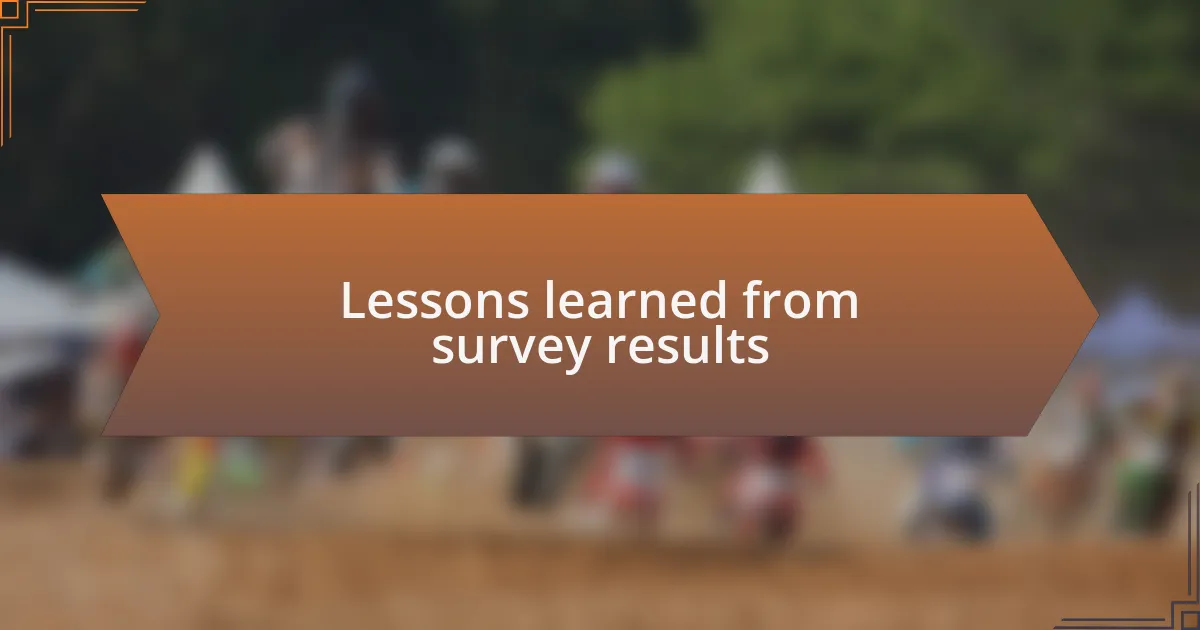
Lessons learned from survey results
When analyzing feedback surveys, I often find that the ‘why’ behind certain ratings is just as important as the ratings themselves. For example, after receiving feedback on an event’s networking session, I decided to reach out directly to a few attendees. Their insights were revealing—a simple change in structure could significantly enhance interaction. Have you ever found that digging deeper into the ‘why’ yields more meaningful insights than surface-level scores?
One lesson I’ll never forget came from a survey that highlighted a consistently mentioned dislike for a particular venue. I initially brushed it off, thinking it was a minority opinion. However, after further reflection, I realized the venue’s layout truly hampered the experience for many attendees. It was a wake-up call—sometimes, the collective voice is more persuasive than our instincts. Isn’t it fascinating how a single detail can paint a much broader picture?
The most impactful lesson emerged when I learned to embrace constructive criticism as a catalyst for creativity. After a less-than-stellar feedback session on our panel discussion, I shifted my focus to collaborating with industry experts on more interactive formats. This not only addressed the concerns raised but also sparked a brand-new energy at our events! What surprises have you encountered when adapting to the feedback you’ve received?
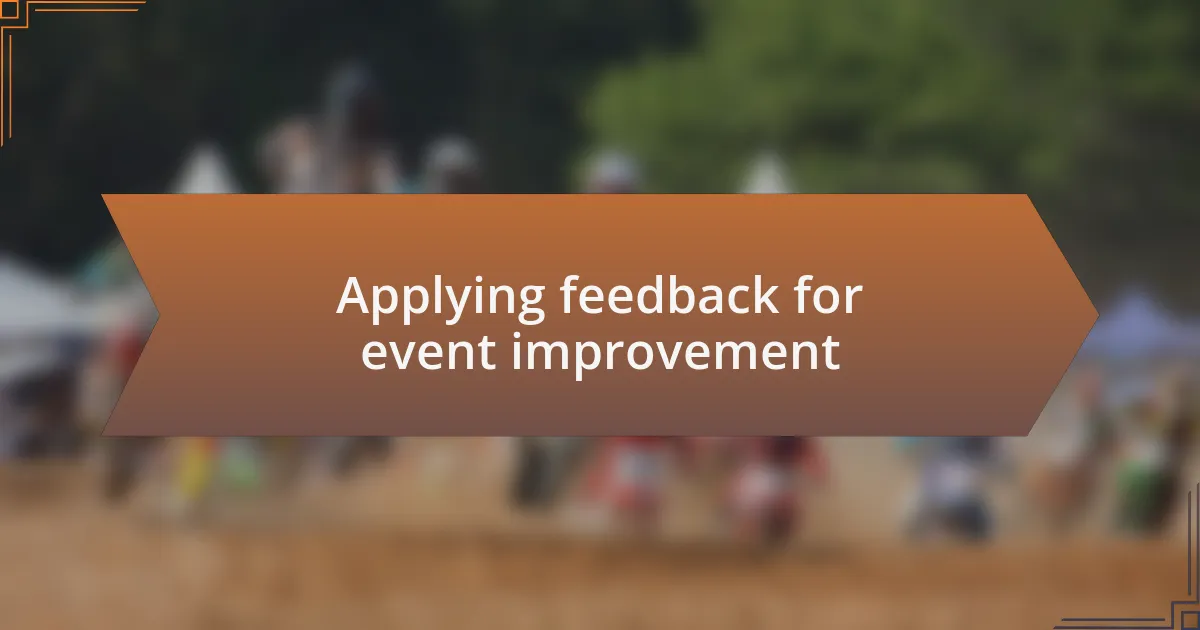
Applying feedback for event improvement
When incorporating feedback into event planning, I’ve discovered that even small adjustments can lead to remarkable improvements. For instance, after participants voiced their desires for more engaging workshops, I decided to include hands-on activities and real-time feedback sessions. The transformation in audience participation was palpable—attendees were not just passive spectators but active contributors to the experience. Have you ever noticed how a little tweak can completely reshape the atmosphere?
Moreover, I learned that consistency is key when applying suggestions from feedback. After a particular event where attendees praised the informative follow-up emails, I took it upon myself to implement a standardized communication strategy across all events. The result? Attendees felt more connected and informed, which, in turn, fostered loyalty and increased attendance for future events. It got me thinking—what would happen if we consistently designed our events with the attendees’ voices in mind?
Embracing diverse perspectives has been another pivotal lesson for me. For example, during a post-event review, I gathered not just feedback from attendees, but also from my team members and vendors. This holistic approach unveiled insights about logistical challenges that I hadn’t considered. Engaging with everyone involved often brings unexpected revelations—have you tried opening the floor to all voices in the feedback process? It might just lead to breakthroughs you didn’t anticipate.